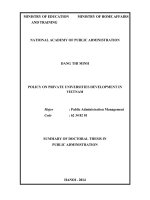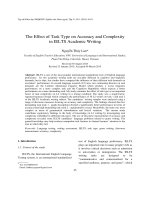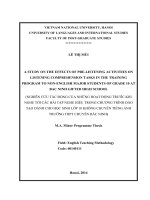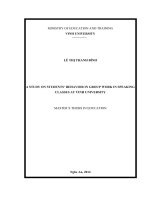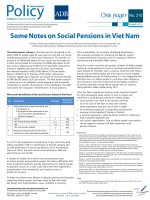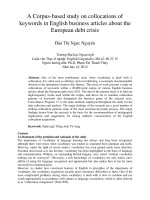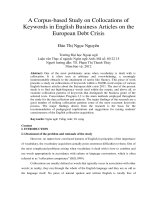Group versus individual focused transformationl leadership on social loafing behavior in virtual teams
Bạn đang xem bản rút gọn của tài liệu. Xem và tải ngay bản đầy đủ của tài liệu tại đây (1.61 MB, 61 trang )
VIETNAM NATIONAL UNIVERSITY, HANOI
VIETNAM JAPAN UNIVERSITY
NGUYEN NHU NAM ANH
GROUP VERSUS INDIVIDUAL-FOCUSED
TRANSFORMATIONAL LEADERSHIP ON
SOCIAL LOAFING BEHAVIOR IN VIRTUAL
TEAMS
MASTER'S THESIS
VIETNAM NATIONAL UNIVERSITY, HANOI
VIETNAM JAPAN UNIVERSITY
NGUYEN NHU NAM ANH
GROUP VERSUS INDIVIDUAL-FOCUSED
TRANSFORMATIONAL LEADERSHIP ON
SOCIAL LOAFING BEHAVIOR IN VIRTUAL
TEAMS
MAJOR: MASTER OF BUSINESS ADMINISTRATION
CODE: 8340101.01
RESEARCH SUPERVISORS:
Associate Prof. KODO YOKOZAWA
Dr. TRAN THI BICH HANH
Hanoi, 2021
ACKNOWLEDGEMENT
A complete study could not be done without any assistance from others.
Therefore, I would like to give my acknowledgement to their support and motivation
during the time of doing this master thesis research as a requirement for completing my
Master of Business Administration at Vietnam Japan University.
First of all, I wish to express my sincere thanks to my supervisors, Associate Prof.
Dr. Kodo Yokozawa and Dr. Tran Thi Bich Hanh for their insightful feedback and
motivation. The research would have been difficult to complete without their guidance
and inspiration.
I would like to express my heartfelt appreciation and gratitude to Ms. Huong,
MBA program assistant, for her unwavering support of my master’s studies and research,
regardless of being on maternity leave during my second year at VJU.
I am also grateful to my classmates, Ms. Do Hai Yen, Ms. Nguyen Thi Anh and
Ms. Nguyen Thi Ha for their encouragement and sharing during the past two years at
VJU. Thanks to them, I received positive peer pressure, which motivated me to conduct
the research proactively and complete the master’s thesis. I would also like to thank Mr.
Nguyen Anh Hao, a senior student at VJU who is currently studying for a Ph.D. at
Yokohama National University, for sharing his experience and knowledge, as well as
supporting me in the process of writing a thesis.
Finally, I want to express my heartfelt gratitude to my parents for their unending
love, care, and support, which has inspired and motivated me throughout my life.
Nguyen Nhu Nam Anh
ABSTRACT
Globalization and the developments in digital and communication technology are
fueling the growth of virtual teams in the workplaces. With the spread of the Coronavirus
disease (COVID-19), the number of virtual group works has increased dramatically
since the beginning of 2020. Employees profit from remote working due to its flexible
working environment, therefore it could become a new standard in the future. Working
effectively in a dispersed area without face-to-face communication, however, can be a
challenge. In a dispersed situation, where social influence and direct supervision are
limited, and the contributions are less apparent, some members may exert less effort
than anticipated. This phenomenon is called social loafing. In virtual teams, leaders are
responsible for members’ working performance as well as individual attitude towards
work, including social loafing behavior. Hence, the purpose of this study is to examine
the effect of two transformational leadership styles (group-focused and individualfocused) on individual social loafing behavior in virtual teams.
To collect samples for quantitative analysis, an online survey questionnaire was
employed. Participants in this study included Vietnamese employees who work remotely
and are currently involved in online projects teams led by managers or team leaders. The
author obtained 461 responses via an online survey, with a total of 249 valid responses
that could be used for data analysis after screening.
The results from multiple regression analysis revealed that group-focused
transformational leadership has no effect on social loafing, while individual-focused
transformational leadership has a negative effect on individual social loafing, with the
exception of intellectual stimulation behavior. This finding will aid managers in dealing
with the challenges of leading virtual team such as productivity loss, particularly social
loafing.
Keywords: transformational leadership, group-focused, individual-focused,
dual-level, social loafing, virtual teams.
TABLE OF CONTENTS
ACKNOWLEDGEMENT .................................................................................................
ABSTRACT ......................................................................................................................
TABLE OF CONTENTS...................................................................................................
LIST OF TABLES ............................................................................................................i
LIST OF FIGURES ........................................................................................................ ii
LIST OF ABBREVIATIONS ........................................................................................ iii
CHAPTER 1. INTRODUCTION ....................................................................................1
1.1. Research Motivation .............................................................................................1
1.1.1. Practical Necessity ..........................................................................................1
1.1.2. Theoretical Necessity ......................................................................................2
1.2. Research Objective ................................................................................................3
1.3. Research Contribution ...........................................................................................3
CHAPTER 2. LITERATURE REVIEW .........................................................................4
2.1. Virtual Teams .........................................................................................................4
2.1.1. Definition of Virtual Teams ............................................................................4
2.1.2. The Benefits and Drawbacks of Virtual Teams ...............................................5
2.2. Leadership in Virtual Teams ..................................................................................7
2.2.1. Virtual Leadership ...........................................................................................7
2.2.2. Transformational Leadership in Virtual Teams ...............................................8
2.3. Group- and Individual-Focused Transformational Leadership .............................9
2.3.1. Group-Focused Transformational Leadership ................................................9
2.3.2. Individual-Focused Transformational Leadership ........................................10
2.4. Social Loafing ..................................................................................................... 11
2.4.1. Definition of Social Loafing ......................................................................... 11
2.4.2. Social Loafing in Virtual Teams ...................................................................12
2.5. Research Gap and Research Question .................................................................13
CHAPTER 3. RESEARCH HYPOTHESIS AND METHODOLOGY ........................14
3.1. Research Hypothesis ...........................................................................................14
3.1.1. Group-Focused Transformational Leadership and Social Loafing ...............14
3.1.2. Individual-Focused Transformational Leadership and Social Loafing.........15
3.2. Research Methodology ........................................................................................16
3.2.1. Population .....................................................................................................16
3.2.2. Sampling Method and Size ...........................................................................17
3.2.3. Data Collection Process ................................................................................17
3.2.4. Data Analysis Approach ................................................................................18
3.2.5. Measurements ...............................................................................................19
CHAPTER 4. DATA PRESENTATION ........................................................................22
4.1. Descriptive Statistics ...........................................................................................22
4.1.1. Frequency Analysis .......................................................................................22
4.1.2. Descriptive Analysis .....................................................................................23
4.2. Reliability Analysis .............................................................................................25
4.3. Exploratory Factor Analysis (EFA) .....................................................................26
4.3.1. Exploratory Factor Analysis for Independent Variables ...............................26
4.3.2. Exploratory Factor Analysis for Dependent Variable ...................................28
4.4. Multiple Regression Analysis..............................................................................28
4.5. Hypothesis Testing ..............................................................................................30
CHAPTER 5. DISCUSSION AND CONCLUSION ....................................................32
5.1. Discussion ...........................................................................................................32
5.1.1. Group-Focused Transformational Leadership and Social Loafing ...............32
5.1.2. Individual-Focused Transformational Leadership and Social Loafing.........33
5.1.3. Considering the Vietnamese Context in this Study .......................................34
5.2. Implication ..........................................................................................................35
5.2.1. Theoretical Implication .................................................................................35
5.2.2. Practical Implication .....................................................................................35
5.3. Conclusion ...........................................................................................................36
5.4. Limitation and Future Research ..........................................................................37
REFERENCES ..............................................................................................................40
LIST OF TABLES
Table 3.1. Measurement Scale for Group- and Individual-Focused Transformational
Leadership .....................................................................................................................19
Table 3.2. Measurement Scale for Social Loafing ........................................................20
Table 4.1. Table of Frequency Statistics .......................................................................22
Table 4.2. Frequency Table of Team Size, Team Tenure and Gender...........................22
Table 4.3. Descriptive Table of Independent Variables ................................................24
Table 4.4. Descriptive Table of Dependent Variable ....................................................25
Table 4.5. Cronbach’s Alpha Table ...............................................................................26
Table 4.6. KMO and Bartlett’s Test of Independent Variables .....................................27
Table 4.7. Rotated Component Matrix of Independent Variables .................................27
Table 4.8. KMO and Barlett’s Test of Dependent Variable ..........................................28
Table 4.9. Regression Analysis Summary.....................................................................29
Table 4.10. Hypothesis Testing Summary ....................................................................31
i
LIST OF FIGURES
Figure 3.1. Research Model ..........................................................................................16
ii
LIST OF ABBREVIATIONS
I-TFL: Individual-Focused Transformational Leadership
G-TFL: Group-Focused Transformational Leadership
SL: Social Loafing
SLTQ: Social Loafing Tendency Questionnaire
TFL: Transformational Leadership
iii
CHAPTER 1. INTRODUCTION
Through demonstrating the research motivation, this chapter presents the subject
to be examined in this thesis. In addition, the research objectives, research questions and
research contributions are discussed in this section below.
1.1. Research Motivation
1.1.1. Practical Necessity
The way people work in organizations nowadays is being reshaped by advances
in information and communication technology, as well as globalization and increased
competition (Bal & Teo, 2000; Bell & Kozlowski, 2002). In the business world, virtual
works have become popular among groupworks (Powell et al., 2004). For their working
practices, groups are increasingly dependent on different communication tools such as
text messaging, email, and video meetings.
According to Dulebohn and Hoch (2017, p. 569), virtual teams are “work
arrangements where team members are geographically dispersed, have limited face-toface contact and work interdependently through the use of electronic communication
media to achieve common goals”. Virtual teams have now been a recent movement
towards working across the organization boundaries, which enables more flexibility and
adaptability for organizations. Remote working in virtual teams has many advantages,
including reduced travel time and costs, increased flexibility to assemble a team of
professionals and expertise across time and distance, improving equal opportunities and
discouraging discrimination (Bergiel et al., 2008).
With the Coronavirus disease (COVID-19) outbreak, organizations worldwide
have adopted remote working or working from home. As a result, the number of group
work in virtual context has increased rapidly since the beginning of 2020. According to
the Statistica Research Department, the number of employees in the US worked at home
five days or so a week has surged to 44 percent during the Coronavirus disease (COVID19) pandemic, compared with 17 percent before the outbreak. 1 Moreover, there is
1
Mlitz, K. (2021, April 09). Remote work frequency before/after COVID-19 2020. Retrieved May 25, 2021,
from />
1
widespread agreement that certain companies will continue to adopt remote working
even after COVID-19. Employees are getting benefits from remote working because of
its flexible working environment, and therefore, this working style could be a new
normal in the future.
However, working effectively in a dispersed area without proper face-to-face
communication can be a challenge (Bell & Kozlowski, 2002). Working in virtual teams
also posit some disadvantages such as technological constrain, communication and
collaboration difficulties. These limitations led to a low level of group cohesion, which
could negatively impact the team performance (Hoch & Kozlowski, 2014). Moreover,
the drawbacks of virtual works such as lack of quality in social interaction might lead to
the emergence of productivity loss (Monzani et al., 2014). Under the dispersed situation,
where social control and direct supervision is reduced, as well as the contributions are
less visible, some members may put in less effort than anticipated on team tasks
(Chidambaram & Tung, 2005). This is known as social loafing, and it is described as the
act of withholding contributions in a team (Karau & Williams, 1993; Latané et al., 1979).
As Bell and Kozlowski (2002) have stated, leadership effectiveness is crucial to
the performance of virtual teams. Hence, leaders are accountable for each member’s
working performance as well as the individual attitude towards work, including social
loafing behavior. Therefore, there is a necessity for conducting research regarding
leadership in virtual context in order to tackle this practical issue.
1.1.2. Theoretical Necessity
The trend towards virtual work in organizations has motivated researchers to pay
more attention to studies on leadership in virtual context. However, Liao (2017)
questioned the current literature on virtual leadership for focusing mostly on team
success rather than individual outcome. In particular, there has been a scarcity of
research on the relationship between leadership effectiveness and social loafing behavior,
especially in the virtual setting.
In terms of leadership style, transformational leadership behavior (TFL) is
thought to have a major influence on the effectiveness of virtual teams (Purvanova &
2
Bono, 2009). Previous research on transformational leadership in virtual context,
however, did not consider separating this leadership style into two distinct behaviors,
namely group-focused and individual-focused leadership (Wang & Howell, 2010). Wu
et al. (2010) found that these two transformational leadership practices had differing
effects on followers. Furthermore, previous research has not looked at the impact of
these two transformational leadership models on social loafing, whether in traditional
collocated teams, or in virtual environments. Research that focuses in particular on the
association between transformational leadership and social loafing in virtual teams is
thus needed.
1.2. Research Objective
The aim of this study is to examine the effect of two transformational leadership
styles (group-focused and individual-focused) on individual social loafing behavior in
virtual teams. The present seeks to address a relevant research question: What effect
does dual-level transformational leadership have on social loafing in virtual teams?
1.3. Research Contribution
The current research intends to make several important contributions. To begin,
it adds to the literature on both transformational leadership and social loafing in virtual
teams by investigating the effect of dual-level transformational leadership on individual
social loafing tendency. Second, this study extends the understanding of social loafing
in workplace settings. Prior studies on social loafing in virtual teams are often performed
at the undergraduate or graduate level at universities. There is a lack of knowledge and
information on how to mitigate social loafing in virtual teams in workplace.
In terms of practical contribution, the present study will attempt to answer a
managerially relevant question: Which transformational leadership behavior is more
successful in overcoming social loafing behavior in a virtual team? Are group-focused
and individual-focused behaviors equally crucial, or is one better than the other? The
answer to this question will help managers in an organization deal better with the
challenge of leading virtual teams, such as productivity loss, particularly social loafing.
3
CHAPTER 2. LITERATURE REVIEW
The research title contains several keywords, such as transformational leadership,
virtual teams, and social loafing. This section would look at the relevant theories
regarding those concepts, as well as pointing out the existing research gaps that are
related to the research problems.
2.1. Virtual Teams
2.1.1. Definition of Virtual Teams
Globalization and increased competitiveness, as well as developments in digital
and networking technology, have allowed a rapid rate of transition than previously
possible, resulting in employment that is more complex and diverse (Bal & Teo, 2000;
Bell & Kozlowski, 2002). These forces have enabled a tendency for firms to collaborate
across corporate boundaries, and, as a result, organizations have grown to be more
adaptable and agile. With the advancement of technologies, organizations have adopted
a modern way of working, which is telework (Bell & Kozlowski, 2002).
Telework is described by Bailey and Kurland (2002, p. 385) as “working outside
the conventional workplace and communicating with it by way of telecommunications
or computer-based technology”. When different teleworkers are formed into a group to
run a project, they will form a virtual group. If those members share a common goal and
work together to achieve it, then the virtual team is formed.
Since the beginning of the twenty-first century, the concept and definition of
virtual teams have appeared in a number of research papers (Bal & Teo, 2000; Bell &
Kozlowski, 2002; Kirkman et al., 2002; Townsend, 1998). Given that the characteristics
of virtual teams have evolved over the last 20 years as a consequence of developments
in communication technologies, the following concept by Dulebohn and Hoch (2017, p.
569) would be used to describe virtual teams. Virtual teams is defined as “work
arrangements where team members are geographically dispersed, have limited face-toface contact and work interdependently through the use of electronic communication
media to achieve common goals”. Despite having several definitions of virtual teams,
4
these concepts all have in common, which is geographically dispersed and using
technology to communicate and collaborate, in order to achieve common goals.
There are two criteria that distinguish virtual teams from traditional teams, which
are spatial distance and communication method (Bell & Kozlowski, 2002). As
traditional team members operate closely together (in the same space or building),
virtual team members are often isolated and distributed in various areas (work from
home or telework). Moreover, members in virtual teams always connect and interact
through a variety of communication technologies such as e-mail, text messaging and
videoconference, since they seldom meet face-to-face as traditional teams. Although
conventional teams also utilize computer mediated technologies for teamwork, such
systems are often used as a complement for face-to-face communication. Bell and
Kozlowski (2002) have argued that the absence of face-to-face contact is what makes
teams virtual.
2.1.2. The Benefits and Drawbacks of Virtual Teams
This segment discusses the advantages and disadvantages of virtual teams.
Without a question, virtual teams hold tremendous potential that it can perform
collaborative tasks that traditional teams can not. The following are some benefits that
enable virtual teams to grow in popularity:
(1) Reduce cost and travel time: with virtual teams, organization can reduce the
cost regarding the accommodation fee, travel, relocation, or daily allowances
costs. Employees who work in virtual teams do not have to worry about any
disruption regarding the daily commute to work. By saving travel time and cost,
employees can spend time on more meaningful activities before starting work in
virtual teams. By adopting the virtual teams’ structure, IBM had saved $50
million for travel and downtime costs (Bergiel et al., 2008).
(2) Allow organization to recruit the most talented employees: virtual teams open
a chance for organization to find top talents who are geographically dispersed
and find it difficult to conduct a business through face-to-face meetings. By
recruiting top talents without any limitation regarding the physical distance,
virtual teams can expand their functional expertise and benefit the organization
5
in terms of competition. In addition, virtual employees can easily work on
different teams, hence companies can maximize their workforce by allowing
team members with specific skills to serve in multiple teams at the same time
(Hertel et al., 2004).
(3) Enhancing equal opportunities in the workplace and discouraging
discrimination: employees who are geographically dispersed will have equal
access to the virtual workplaces, thereby allowing the organization to
accommodate the specific needs of those physically distanced employees.
Moreover, conducting business online creates an environment that promotes
equality and equity among employees, since the performance management of
employees in virtual workplaces is mainly based on their productivity and work
outcomes rather than any other attributes (Bergiel et al., 2008).
On the other hand, research also suggested that virtual teams face a number of
obstacles as opposed to traditional teams. Some of the main drawbacks are included
below:
(1) Technological difficulties: Although technology has become an essential tool
for organizations, not everyone in virtual teams benefits from the use of
computers and other electronic devices such as laptops or smartphones. Virtual
teams may experience the generation gap, which eventually led to an issue that
there is a lack of expertise in technological applications within mature senior
managers (Bergiel et al., 2008). According to Johnson et al. (2001), the
introduction of virtual teams would produce problems such as technophobia, a
term that describes workers who are unfamiliar with computers and other
telecommunication technology.
(2) Communication and collaboration difficulties: one of the biggest issues
involved in working in virtual teams is communication, which can be described
in three different aspects: (a) lack of project visibility – team members were
unsure of what tasks they needed to complete; (b) getting in touch with people –
a member sent a question or message to another team member but never received
a response, or received a delayed reply, leading to further frustration among team
6
members; and (c) technological constraints – members had difficulties
understanding the meaning of text-based messages, since it lacks non-verbal cues
(Johnson et al., 2001).
(3) Difficulties in creating trust: trust plays an important role in preventing
geographical distance from leading to psychological distance in a virtual team
(Jarvenpaa et al., 1998). However, with the communication difficulties
mentioned above, virtual teams might experience more challenges than
conventional teams in building trust among team members. Past research has
shown that it is more challenging to develop social relationships through
computer mediated communication due to the depersonalization effect
(Kanawattanachai & Yoo, 2002). Therefore, virtual teams might experience the
lack of affect-based trust, which involves the emotional elements and social skills
of trustees (Kanawattanachai & Yoo, 2002).
2.2. Leadership in Virtual Teams
2.2.1. Virtual Leadership
The concept of virtual leadership is “a social influence process mediated by
advanced information technologies to produce changes in attitudes, feelings, thinking,
behavior, and/or performance of individuals, groups, and/or organizations” (Hambley et
al., 2007).
The unique features of virtual teams require different demands for leadership
compared with conventional teams (Huang et al., 2010). Many academics accept that
leading virtual teams is more daunting than leading conventional face-to-face teams
(Bell & Kozlowski, 2002; Hoch & Kozlowski, 2014; Liao, 2017). According to
Purvanova and Bono (2009), leaders of virtual teams must spend significantly more time
and resources to ensure the team performs equivalently to face-to-face teams. Given the
limited richness of social information through digital networking media resources,
virtual leaders may need to take a proactive approach and spend more effort to assist in
the coordination of team activities, the development of relationships among team
members, and the facilitation of team processes (Bell & Kozlowski, 2002; Liao, 2017;
Purvanova & Bono, 2009). Therefore, leadership effectiveness is critical to the
7
sustainability of virtual teams (Bell & Kozlowski, 2002; Hambley et al., 2007; Liao,
2017).
2.2.2. Transformational Leadership in Virtual Teams
While various approaches to leadership studies exist, transformational leadership
was selected as a main subject in the present research. There are several explanations
why this leadership theory was chosen. Initially, transformational leadership was
proposed by Bass (1985), and it has been endorsed by comprehensive studies since then
(Hambley et al., 2007). Several studies have often emphasized the significance of
transformational leadership in virtual teams (Bell & Kozlowski, 2002; Purvanova &
Bono, 2009). This paradigm may also be used to provide practical recommendation in
leadership training (Hambley et al., 2007). Moreover, researchers who focus on virtual
leadership will be able to improve their quality of research by adopting research methods
and measurements which have been verified in the form of developed theories in
traditional leadership research (Zhang & Fjermestad, 2006).
Transformational leader emphasizes motivating and inspiring followers to
perform beyond expectation, stimulating thinking that drives innovative solutions to
tackle problems and generating follower trust, confidence, and admiration (Balthazard
et al., 2009; Hambley et al., 2007). Idealized influence, inspirational motivation,
intellectual stimulation, and individualized consideration are the four dimensions of this
leadership style (Bass, 1985).
Purvanova and Bono (2009) argued that transformational leadership is essential
in teams that experience difficulties in communication due to technology constrain.
According to the findings of this study, transformational leadership has a greater impact
on team outcomes in virtual teams than in conventional face-to-face teams.
However, the academic literature on leadership in virtual contexts is only in its
early stages, with just a few studies concentrated specifically on the effect of
transformational leadership in virtual teams. Furthermore, Liao (2017) stated that the
latest literature focuses primarily on the impact of leadership on team level outcomes,
rather than individual level outcomes.
8
2.3. Group- and Individual-Focused Transformational Leadership
This study takes a step further by exploring the two types of transformational
leadership behaviors: group-focused transformational leadership (G-TFL) and
individual-focused (I-TFL) transformational leadership. The theory regarding G-TFL
and I-TFL behavior was proposed first by Kark and Shamir (2002), but prior studies
have only viewed transformational leadership as an overarching model and neglected to
differentiate between group-focused and individual-focused leadership behaviors (Wang
& Howell, 2010). It was not until Wu et al. (2010) published an article that directly
addressed the gap on how differentiated transformational leadership impacts group
performance. The study by Wu et al. (2010) was followed by Wang and Howell (2010),
who also investigated the impact of these two leadership behaviors on group
performance and individual task performance. Since then, several papers have been
concentrating on analyzing the effect of G-TFL and I-TFL on different outcomes such
as team performance (Chun et al., 2016; Wang & Howell, 2012), individual
psychological empowerment (Wang & Howell, 2012) or creative behavior (Dong et al.,
2017; Tse & Chiu, 2014). Nonetheless, these studies were conducted mostly in
collocated face-to-face context. Until now, there has been relatively little study on the
impact of this dual-level transformational leadership in the virtual context.
While Wu et al. (2010) measured the TFL behaviors based on the theory proposed
by Bass (1985), Wang and Howell (2010) have extended their research model on duallevel transformational leadership by developing a new TFL dimension and scale to
measure these two factors and tested this preliminary model which has a reliable
outcome. Therefore, the definitions of G-TFL and I-TFL developed by Wang and Howell
(2010) will be used in this study.
2.3.1. Group-Focused Transformational Leadership
Wang and Howell (2010) described group-focused transformational leadership
as action that emphasizes the significance of group objectives, strengthens mutually
shared values and principles, and inspires a concerted effort to achieve group goals.
Group-focused transformational leadership has three dimensions: (1) emphasizing
group identity, (2) communicating a group vision, and (3) team-building.
9
(1) Emphasizing group identity highlights the mutual characteristics of group
members and stresses the group affiliation of the followers. This action was modeled
after the idealized influence dimension in the traditional transformational leadership
proposed by Bass (1985). Showing pride in the group’s accomplishments and
achievements, highlighting shared goals and ideals among members, emphasizing the
team’s uniqueness, and saying positive things about the team are all examples of
emphasizing group identity.
(2) Communicating a group vision entails articulating an idealized and appealing
view of the team’s potential. This dimension is derived from Bass (1985) definition of
inspirational motivation, which relates to the action that motivates and inspires
followers to pursue a common vision in order to reach collective goals that seem
unreachable. Leaders, for example, can speak optimistically regarding the team’s
prospects or be positive about what the team will achieve. Leaders may also show
confidence in what the team will do in the coming years, as well as communicate a
consistent vision for the project.
(3) Team-building is characterized as encouraging collaboration, resolving
disputes, and fostering mutual confidence among team members. Examples of teambuilding include developing a team mentality and spirit, resolving disagreements among
team members for the sake of the team’s goals, and promoting mutual trust among
members.
2.3.2. Individual-Focused Transformational Leadership
Individual-focused transformational leadership is described as an action that
empowers individual followers to reach their full potential, strengthen their abilities and
skills, and boost their self-efficacy and self-esteem (Wang & Howell, 2010). I-TFL can
be divided into four distinctive dimensions: (1) communicating high expectations, (2)
follower development, (3) intellectual stimulation and (4) personal recognition.
(1) Communicating high expectations shows the leader’s aspirations of followers
for excellence, efficiency, and high result. This dimension arose from Bass (1985) TFL
theory of inspirational motivation. Leaders who exhibit this behavior inspire supporters
10
to set high expectations for themselves, demonstrating a total confidence in them and
their abilities to accomplish certain goals.
(2) Follower development aims to enhance followers’ skills and abilities. This
dimension derives on the individual consideration dimension developed by Bass (1985),
which is defined as paying careful attention to each individual’s desire for success,
serving as coach and tutor, and offering learning opportunities. Leaders, for example,
may suggest different training methods to help followers improve their ability to carry
out the job, providing coaching to help followers enhance job performance, and giving
feedback to help them understand.
(3) Intellectual stimulation is defined as encouraging followers to be innovative
through questioning assumption, reframing issues, and addressing problems in novel
ways. This dimension is aligned with the similar TFL dimension proposed by Bass
(1985), in which leaders should give followers the ability to think independently,
challenge them to look at the issue from various perspectives, and come up with creative
ideas and solutions.
(4) Personal recognition praise and acknowledge followers for meeting specific
objectives or finding innovative ways. This dimension is adopted from the contingent
reward dimension in transactional leadership behavior, which is characterized as
rewarding followers for achieving specific performance goals (Bass, 1985). Examples
of personal recognition include commending followers when they achieve their goals,
giving them positive feedback for a good performance, or acknowledging the
improvement in followers’ quality of work.
2.4. Social Loafing
2.4.1. Definition of Social Loafing
Social loafing is defined as the act of withholding contributions in a team (Karau
& Williams, 1993; Latané et al., 1979). In other words, individuals may make less effort
when working collaboratively than when working alone (Peñarroja et al., 2017). George
(1992) considered social loafing as an explanation for productivity losses in group
working. The phenomenon of social loafing has become an interesting topic and
attracted many researchers since the early twentieth century, starting with Maximilien
11
Ringelmaan (Alnuaimi et al., 2010). He was the first theorist to describe this
phenomenon, which other researchers also called social loafing as the Ringelmaan effect.
To understand social loafing, many theories have been suggested, including the
social impact theory, the output equity theory, or the matching-to-standard theory
(Alnuaimi et al., 2010). Some scholars have recently based their analysis of social
loafing on motivation theories and established several antecedents, such as lack of
identification of individual contribution to the group, low intrinsic commitment, and low
group cohesiveness (Liden et al., 2004). There is a consensus among researchers that
the underlying causes of social loafing are motivational in nature (George, 1992; Liden
et al., 2004).
2.4.2. Social Loafing in Virtual Teams
As the number of virtual team works has increased rapidly due to the advance of
technology in recent years, productivity loss, particularly social loafing, has become an
urgent topic for information systems researchers (Alnuaimi et al., 2010; Dennis et al.,
2012). Under the dispersed situation, where social control and direct supervision is
reduced, as well as the contributions are less visible, some members may spend less
effort than expected and team task (Chidambaram & Tung, 2005). Moreover, the
drawbacks of virtual works such as lack of quality in social interaction might lead to the
emergence of productivity loss, particularly social loafing behavior (Monzani et al.,
2014). Hence, there is a possibility that virtual teams might exhibit social loafing
behavior more regularly than traditional collocated teams.
Several antecedents of social loafing in virtual context have been discovered in
previous studies. Group size and dispersion are the two key causes of social loafing
behavior in virtual teams (Chidambaram & Tung, 2005). Alnuaimi et al. (2010) has
extended the research model on team size and dispersion and identified several
mediating mechanisms such as diffusion of responsibility, dehumanization, and
attribution of blame. Perry et al. (2016) proposed that work-family circumstances can
lead to the tendency of social loafing in virtual teams. Moreover, in a technologysupported team, digital communication has been described as a supporting condition for
social loafing (Monzani et al., 2014).
12
Several previous studies have listed the impact of transformational leadership on
social loafing (Chen et al., 2020; Kahai et al., 2003; Khan et al., 2020). There is an
agreement among these studies that transformational leadership negatively influences
social loafing. Kahai et al. (2003) proposed and tested the research model regarding
leadership effectiveness on social loafing in an electronic context. However, these
findings continued to treat transformational leadership as a broad concept, failing to
distinguish between group-focused and individual-focused behaviors. According to Wu
et al. (2010), G-TFL and I-TFL can affect followers differently. Hence, the aim of this
study is to fill a void in the existing literature concerning transformational leadership
and social loafing behavior.
2.5. Research Gap and Research Question
Despite the fact that a variety of studies have been undertaken to investigate the
antecedents of social loafing, research regarding the leadership effect on this behavior
is still very limited. Furthermore, there has been a relatively small number of research
that examine the effects of transformational leadership on social loafing, nor has there
been prior research that studies the relationship between dual-focused leadership and
loafing behavior in virtual contexts. Moreover, Wang and Howell (2012) proposed that
future research could investigate the cross-level impact of dual-level transformational
leadership on individual-level outcomes such as individual work behavior or attitude.
Hence, there is a need for research that directly reflects on the linkage between
transformational leadership and individual social loafing in virtual teams.
Based on the existing gap in the literature review of transformational leadership
and social loafing, this study attempts to answer the research question: What effect does
dual-level transformational leadership have on social loafing in virtual teams?
13
CHAPTER 3. RESEARCH HYPOTHESIS AND METHODOLOGY
3.1. Research Hypothesis
3.1.1. Group-Focused Transformational Leadership and Social Loafing
Group-focused TFL emphasizes the significance of group goals, strengthens
mutually held ideals and values, and inspires a united commitment to accomplish group
goals (Wang & Howell, 2010). The focus on teamwork emphasizes the group’s mutual
effectiveness, implying that by collaborating, team members may achieve better
performance. This type of leadership aims to increase followers’ intrinsic motivation,
which enhances their interest in discussions and collaboration with others (Kahai et al.,
2003). With a high degree of inspirational motivation, group-focused TFL behavior may
minimize social loafing by assisting team members in perceiving that the ongoing group
challenge is critical and requires mutual contributions to the group, as well as their
contributions being distinct and important for improved group success. In other words,
by communicating group vision and fostering collaboration among team members,
leaders can help the team in overcoming social loafing by making members associate
greater intrinsic value with "working together" and "learning from each other" (Kahai et
al., 2003).
According to Lam (2015), a group that exhibits higher team cohesion – the degree
to which a team is united and dedicated to achieving a particular work goal, is likely to
experience less social loafing behavior. Moreover, group-focused TFL has a beneficial
impact on followers’ helping behavior, which is described as willingly assisting other
members of the group with work-related problems (Wang & Howell, 2010). Finally,
group-focused TFL stresses the value of group identity, which is favorably linked to
individual performance and psychological empowerment, according to Wang and
Howell (2012). Therefore:
Hypothesis 1: Group-focused transformational leadership (G-TFL), including
emphasizing group identity (H1a), communicating a group vision (H1b) and teambuilding (H1c), are negatively related to individual social loafing behavior.
14
3.1.2. Individual-Focused Transformational Leadership and Social Loafing
Individual-focused TFL seeks to inspire individuals to reach their full potential,
strengthen their abilities and skills, and improve their self-efficacy and self-esteem
(Wang & Howell, 2010). When transformational leaders show individual care and
compassion for their followers, they motivate them to engage in more in-role activities
needed by their leader (Dirks & Ferrin, 2002). By creating an emotional bond, leaders
motivate followers and enhance their personal initiative, which defines as an extent to
go above and beyond their job role and assist others (Judge & Piccolo, 2004; Wang &
Howell, 2010). When transformational leaders set high performance expectations, this
behavior can enhance followers’ perceived ability to achieve task, which not only
motivates them to perform a better in-role performance, but also creates a sense of
responsibility to ensure that they fulfill their own duty in the team.
There is a follower development behavior inside individual-focused
transformational leadership that helps to improve followers’ skills and abilities by
paying particular attention to each individual’s desire for success, serving as a coach and
tutor, and offering learning opportunities. (Wang & Howell, 2010). This dimension
derives on the individual consideration introduced by Bass (1985), and according to
Kahai et al. (2003), individual consideration may aid in increasing followers’ sense of
psychological empowerment, hence deflating the level of social loafing.
Moreover, by encouraging followers to be independent thinkers, transformational
leaders can help them enhance self-determination over their own work (Wang & Howell,
2012). Hence, this study advances the following hypothesis:
Hypothesis 2: Individual-focused transformational leadership (I-TFL), including
communicating high expectation (H2a), follower development (H2b), intellectual
stimulation (H2c) and personal recognition (H2d) are negatively related to individual
social loafing behavior.
Figure 3.1 below present the research model of this study:
15
Emphasizing group identity
Communicating group
vision
H1a (-)
H1b (-)
Team-building
H1c (-)
Communicating high
expectations
Follower development
Intellectual stimulation
H2a (-)
Social loafing
H2b (-)
H2c (-)
H2d (-)
Personal recognition
Figure 3.1. Research Model
3.2. Research Methodology
In this study, a quantitative analysis approach was used, with samples collected
from an online survey-questionnaire. By exploring the association between dual-level
transformational leadership and social loafing in a virtual team workplace, this
quantitative study contributes to a better understanding of the impact of these two
leaderships style on followers’ behavior. The collected data was analyzed using the
software IBM SPSS Statistics Subscription Trial version 27.
3.2.1. Population
The population of interest for this quantitative analysis was any Vietnamese
individual who is currently engaging in online project teams in organizations, both
within and outside Vietnam. Those individuals were the members/followers of the teams,
each of which is headed by one manager or one team leader. Since the research model
on the preliminary effect of transformational leaderships on social loafing behavior in
general, this study did not consider separating the team type, team structure, as well as
16


